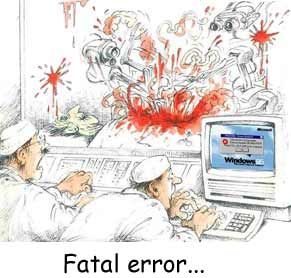| Hi,
Thanks for the wonderful blog. I'm a senior Hematology-Oncology Fellow from Tampa, FL. I have been using PDAs since I graduated Med School in 1998. Palm III, then Visor Deluxe, then Treo 90, now Tungsten T3. In terms of programs: Calculators: Haemonc Rules (Best By Far, most useful); MedRules, Medmath (with Epocrates); Adjuvant! PDA program (adjuvantonline.com) Drug Guides: Epocrates (like updates and pricing of meds that are included); Lexi-Drugs (more info) Chemo Guides: OncoMD 04 (Comprehensive); Adverse event program from Amgen (received at Asco 2004); Chemo RX Plus (but no updates recently) Staging: AJC TNM Other: Documents to Go (ok for schedules, etc); Bonsai (for notes); Repligo (to read PDF Files, including NCCN guidelines). For Fun: Audible (great service); Pocket Tunes (best player). Anyway, I've managed to convert most of the fellows to using their device more often. I hope more MD's use their PDA to maximize their patient care, not just keeping phone numbers and datebook. |
Nice to hear from you Yousuf. Have sent you a Gmail invite. 5 more Gmail invites left folks!
Btw, glad to hear you like Haemoncrules. Just to let you know version 1.8 is ready but have been on vacation so will put it up for download when I get back home.
 PA ToolBox provides the most valuable modules from ERSuite for the PA working in the critical care, emergency or primary care environment. This product also provides substantial textbook type content in the areas of ENT and Infectious Disease, covering all common complaints. 15 task specific sections (modules) are now included, with rapid access to content via our easy to use search tool
PA ToolBox provides the most valuable modules from ERSuite for the PA working in the critical care, emergency or primary care environment. This product also provides substantial textbook type content in the areas of ENT and Infectious Disease, covering all common complaints. 15 task specific sections (modules) are now included, with rapid access to content via our easy to use search tool RxCalc (formerly known as Dosecalc) is an essential tool for Pediatricians.
RxCalc (formerly known as Dosecalc) is an essential tool for Pediatricians.

 The market leader among all books for Step 3, Crush is an easy-to-use and effective high yield review for USMLE Step 3. The concise presentation is perfect for the busy house officer who needs a review that hits all the commonly tested concepts. The coverage also weaves in the case-based scenarios that are important part of Step 3.
The market leader among all books for Step 3, Crush is an easy-to-use and effective high yield review for USMLE Step 3. The concise presentation is perfect for the busy house officer who needs a review that hits all the commonly tested concepts. The coverage also weaves in the case-based scenarios that are important part of Step 3.
 This convenient handheld reference is a quick one-stop guide to prescribing psychotropic drugs for patients at every stage of the life span—children, adolescents, adults, and the elderly. With a tap of a stylus, clinicians can get reliable, succinct, and easy-to-scan information about any drug, including what formulations are available, how to prescribe for each age group, how the drug compares to alternative treatments, and what precautions are necessary. Coverage encompasses all current psychotherapeutic medications, including agents used to treat substance abuse.
This convenient handheld reference is a quick one-stop guide to prescribing psychotropic drugs for patients at every stage of the life span—children, adolescents, adults, and the elderly. With a tap of a stylus, clinicians can get reliable, succinct, and easy-to-scan information about any drug, including what formulations are available, how to prescribe for each age group, how the drug compares to alternative treatments, and what precautions are necessary. Coverage encompasses all current psychotherapeutic medications, including agents used to treat substance abuse.  First published in 1959, the "Big Red Book," as it's come to be known, has gone the extra mile for pharmacists and healthcare professionals seeking answers to the most detailed questions. It provides more extensive evidence-based data than any other drug reference and is now available for the PDA.
First published in 1959, the "Big Red Book," as it's come to be known, has gone the extra mile for pharmacists and healthcare professionals seeking answers to the most detailed questions. It provides more extensive evidence-based data than any other drug reference and is now available for the PDA.